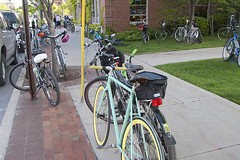Transportation Secretary LaHood leads the way on sustainability

Posted June 18, 2009 at 1:30PM
This is not your father's DOT. A couple of days ago I wrote a post on the remarkable (and now three-agency) partnership on sustainable communities within the Obama administration. Secretaries Ray LaHood (DOT) and Shaun Donovan (HUD) and Administrator Lisa Jackson (EPA) are placing the sustainability agenda front and center, committing the federal government to join forces with states and localities in making the places where we live, work, shop and play more livable, affordable, connected and environmentally friendly. All three deserve our praise; so do their staffs who have been working on this; and so, for that matter, does their boss in the White House.
Today I want to give a particular shout out to Department of Transportation Secretary LaHood, a few months ago just a little-known Republican (!) Congressman from downstate Illinois.  I have to confess that I didn't know what to think one way or another when the Obama team announced his appointment. But, from today's vantage point, wow.
I have to confess that I didn't know what to think one way or another when the Obama team announced his appointment. But, from today's vantage point, wow.
The first major signal came in March, when LaHood and Donovan announced the interagency partnership. I wrote about the announcement then - emphasizing the agencies' intention to "have every major metropolitan area in the country conduct integrated housing, transportation, and land use planning and investment." You'd be surprised how few regions do this now. In defiance of logic, land use and transportation are considered independently, and the results of that are all too apparent on our chaotic landscape and soaring carbon emissions from driving. This in itself was big.
A few days later, LaHood elaborated on the concepts in his own blog:
"We'll look for ways our two departments can further coordinate location efficiency [a phrase that I believe was coined by my NRDC colleague David Goldstein] in housing and transportation choices for states, counties, and municipalities.
"On a less concrete level, the task force will evaluate and recommend measures that indicate livability. After all, if we don't know livability when we see it, how can we know if we've helped communities achieve it?
"I have a few ideas. For example, I think everyone, urban and rural alike, needs safe and affordable access. Access to work, to medical services, to schools, to shopping, to recreation, and to other essential activities.
"We're moving into new territory, and it must be mapped out. We need better tools to track housing and transportation options and expenditures. We need standardized and efficient performance measures. We need to learn from what works.
"In the coming months, we'll work closely with Congress and our stakeholders on a new authorization package for surface transportation--the sidewalks, roads, rails, and transit that move you where you want to go, that move your goods where you need them. With your support, we can make livability a centerpiece of this legislation."
(There is currently some skirmishing going on regarding the timing of the reform legislation, with some reported disagreement between the administration and Congress on the issue. I'll have more to say about that at the bottom of the post, but it in no way detracts from the terrific leadership the Secretary is showing on the substance of sustainability.)
 The mention of sidewalks in LaHood's writing is significant. Walking is the most environmentally efficient means of transportation of all, yet it has traditionally been completely ignored in transportation planning and investment. Despite some good procedural reforms over the years (particularly in the Intermodal Surface Transportation Efficiency Act of 1991), and the implementation of some innovative transportation programs that have been relatively small compared to the agency's overall budget, DOT's core mission for several decades now has remained giving money to states for highways, with very few strings attached. To have the head guy talking about a new direction, emphasizing location efficiency, access, performance measures, and livability is huge - and badly needed.
The mention of sidewalks in LaHood's writing is significant. Walking is the most environmentally efficient means of transportation of all, yet it has traditionally been completely ignored in transportation planning and investment. Despite some good procedural reforms over the years (particularly in the Intermodal Surface Transportation Efficiency Act of 1991), and the implementation of some innovative transportation programs that have been relatively small compared to the agency's overall budget, DOT's core mission for several decades now has remained giving money to states for highways, with very few strings attached. To have the head guy talking about a new direction, emphasizing location efficiency, access, performance measures, and livability is huge - and badly needed.
The announcement earlier this week bringing EPA into the partnership only strengthens the new direction. On Tuesday, I wrote about the core principles announced for the partnership. But the agencies' full statement, which was not yet available when I wrote that entry, also discusses the methods by which their partnership will pursue those goals, and they are all about smart growth. Here are some excerpts:
- Enhance integrated planning and investment. The partnership will seek to integrate housing, transportation, water infrastructure, and land use planning and investment. HUD, EPA and DOT propose to make planning grants available to metropolitan areas, and create mechanisms to ensure those plans are carried through to localities.
- Provide a vision for sustainable growth. This effort will help communities set a vision for sustainable growth and apply federal transportation, water infrastructure, housing and other investments in an integrated approach that reduces the nation's dependence on foreign oil, reduces greenhouse gas emissions, protects America's air and water and improves quality of life . . .
- Redefine housing affordability and make it transparent. The partnership will develop federal housing affordability measures that include housing and transportation costs and other expenses that are affected by location choices. Although transportation costs now approach or exceed housing costs for many working families, federal definitions of housing affordability do not recognize the strain of soaring transportation costs on homeowners and renters who live in areas isolated from work opportunities and transportation choices. The partnership will redefine affordability to reflect those costs . . .
 Redevelop underutilized sites. The partnership will work to achieve critical environmental justice goals and other environmental goals by targeting development to locations that already have infrastructure and offer transportation choices . . .
Redevelop underutilized sites. The partnership will work to achieve critical environmental justice goals and other environmental goals by targeting development to locations that already have infrastructure and offer transportation choices . . . - Develop livability measures and tools . . . HUD, DOT and EPA will help communities attain livability goals by developing and providing analytical tools to evaluate progress as well as state and local technical assistance programs to remove barriers to coordinated housing, transportation and environmental protection investments. The partnership will develop incentives to encourage communities to implement, use and publicize the measures.
- Align HUD, DOT and EPA programs. HUD, DOT and EPA will work to assure that their programs maximize the benefits of their combined investments in our communities for livability, affordability, environmental excellence, and the promotion of green jobs of the future.
- Undertake joint research, data collection and outreach.
(Emphasis in original.) This is exactly what we need, and we should all look forward to helping them succeed. But Secretary LaHood has been busy on some separate (if very consistent) initiatives as well.
Take high-speed rail, for example, one of the President's favorite transportation projects. Earlier this month LaHood and Vice President Biden met with eight state governors, along with transportation officials from 15 additional states, in a roundtable to discuss the administration's plans "to jump-start a potential world-class passenger rail system and set the direction of transportation policy for the future." The Secretary has been out front on the issue, writing on his blog:
"It's the right thing to do for our mobility - and for the environment. A single railroad track can carry as many people as a 10-lane highway. That could help to relieve congestion. And rail systems powered by clean diesel or electric power are energy-efficient. They're capable of removing billions of pounds of carbon dioxide from the atmosphere each year.
"Years from now, Americans will look back on this time as a game-changer. A time when we got serious about putting public transportation to work on behalf of all Americans. A time when we recognized that passenger rail can play a key role in making our communities more livable and sustainable."
LaHood's DOT is also seeking Congressional approval to invest $604.3 million in 10 new or expanding city and metro transit projects across the country, and he has approved federal ARRA relief funds to help 11 others already under way. He has elaborated on these initiatives on his blog and in an address to the American Public Transportation Association. And LaHood has even spoken up on behalf of bicycling as "an important factor in less carbon-intensive commuting."
To top it all off, he has made great appointments to posts in DOT. My friend Roy Kienitz, whose career has included outstanding service on transportation and related issues to the late Senator Daniel Patrick Moynihan and governors Glendening (Maryland) and Rendell (Pennsylvania), as well as leading the nonprofit Surface Transportation Policy Project, is now DOT Undersecretary for Policy. There is no one whose judgment I trust more on transportation policy matters.
Roy's appointment was followed up by the announcement that Polly Trottenberg, another Moynihan veteran (the late senator was primarily responsible for the landmark ISTEA legislation in 1991 and was a giant intellect on infrastructure issues), would be joining the team as assistant secretary for transportation policy. Polly also served as legislative director for Senators Barbara Boxer and Charles Schumer, and more recently has been executive director of Building America's Future, a bipartisan coalition co-chaired by California Governor Arnold Schwarzenegger, Pennsylvania Gov. Edward Rendell, and New York City Mayor Michael Bloomberg.
 Other big-time appointments at DOT have included John Porcari of Maryland as Deputy Secretary, Victor Mendez as head of the Federal Highway Administration, Peter Rogoff as head of the Federal Transit Administration, and Joe Szabo to head the Federal Railroad Administration. It is not without significance that so many of these appointments have substantial legislative experience. As noted above, the massive federal transportation law is due for reauthorization in this Congress, whether it occurs this year or next, and I believe Obama and LaHood are assembling a team deep in Congressional experience specifically in order to bring about the change they have signaled in their rhetoric.
Other big-time appointments at DOT have included John Porcari of Maryland as Deputy Secretary, Victor Mendez as head of the Federal Highway Administration, Peter Rogoff as head of the Federal Transit Administration, and Joe Szabo to head the Federal Railroad Administration. It is not without significance that so many of these appointments have substantial legislative experience. As noted above, the massive federal transportation law is due for reauthorization in this Congress, whether it occurs this year or next, and I believe Obama and LaHood are assembling a team deep in Congressional experience specifically in order to bring about the change they have signaled in their rhetoric.
That's a lot for, what, five months so far? Mostly words, true. But that's where leadership begins. And it's the first time we've had it at DOT since I've been working on these issues.
As for the administration's desire to put off consideration of major transportation reform until next year, environmentalists should not necessarily view that as a bad thing. DOT's terrific appointments are new, and just settling in. The legislative calendar is already full with hugely important items such as health care and climate change. And the recession distorts the issues surrounding any major funding bill such as transportation in ways that could be counterproductive to the reforms we hope to see. Both of the last two major transportation reauthorizations also involved postponements, so this is far from unprecedented.
The only downside is that House Transportation and Infrastructure chairman Jim Oberstar (also a friend of reform) has been eager to get going, and as of this writing has been planning to introduce a 100-page outline of his proposals later this morning. So this creates a bit of tension between two pockets of leadership who are really on the same side. That's not good, but in the long run the law could be better for the delay.